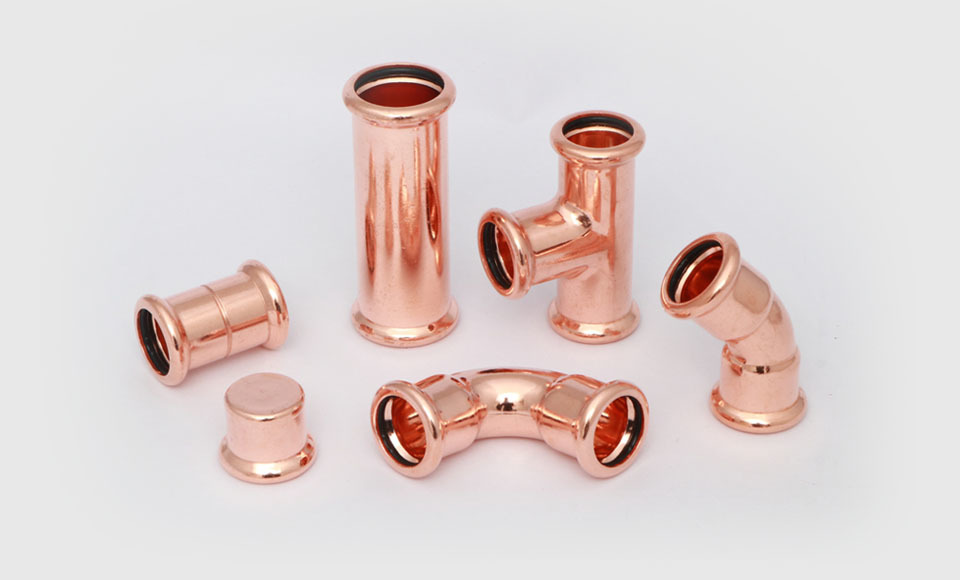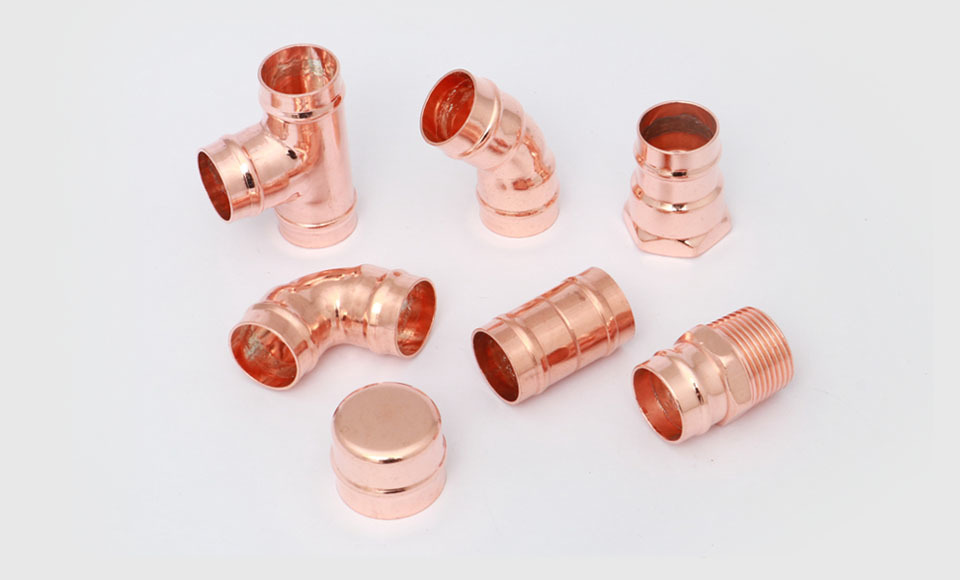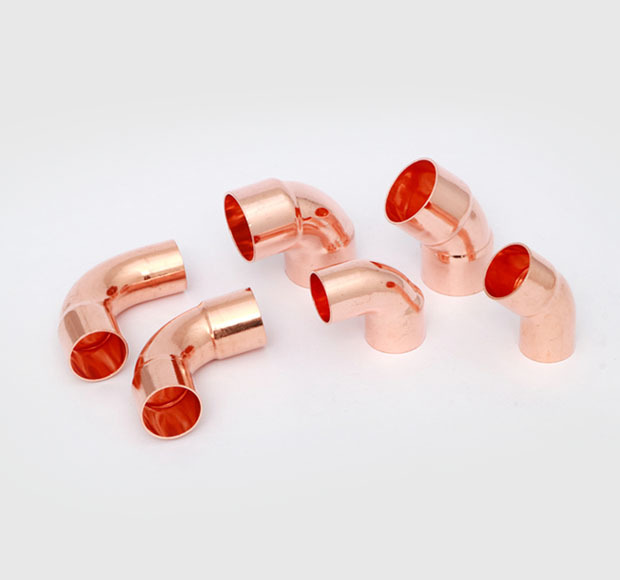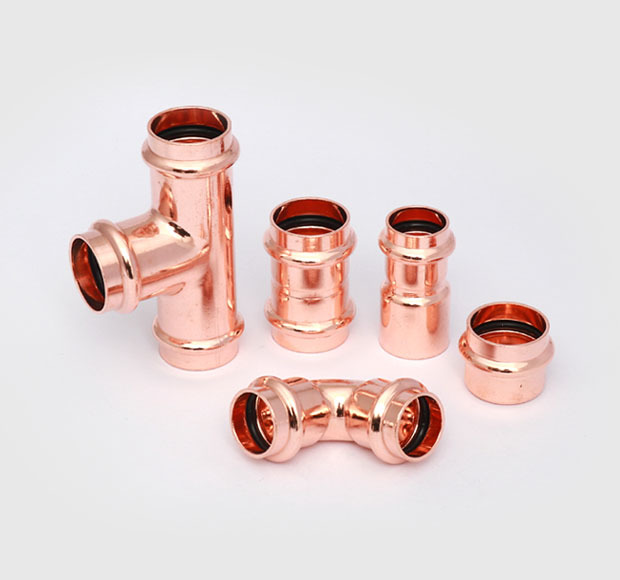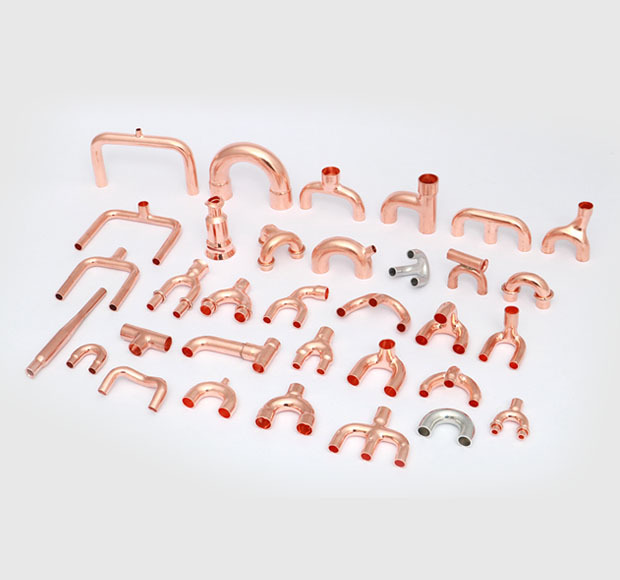Support
Frequently Asked Question
Function classification: divided into casing joint, reducing joint, 90 ° elbow, 45 ° elbow, tee joint, reducing tee joint, four-way joint, reducing four-way joint, union joint (valve conversion joint), flange, and pipe clamp.
According to the connection method, it can be divided into socket welding, threaded connection, flange connection, and new fast connection.
Classified by material: divided into red copper, brass, and bronze.
Classified by purpose: divided into water pipe fittings, air conditioning pipe fittings, and refrigeration pipe fittings.
1. To prevent erosion between layers due to heating, the welding current should not be too sticky, which is 20% less than that of carbon steel welding rods. The arc should not be too long, and the interlayer cooling should be fast. It is advisable to use a narrow weld bead.
2. Stainless steel pipe fittings have a sticky hardening property after welding and are prone to cracking. If typical stainless steel pipe fittings are accepted for welding, preheating above 300 ℃ and slow cooling treatment at 700 ℃ after welding must be carried out. If the weldment cannot undergo post weld heat treatment, stainless steel pipe welding rods should be used.
3. Stainless steel pipe fittings, in order to improve corrosion resistance and weldability, appropriate amounts of invariable elements such as Ti, Nb, Mo, etc. are added, resulting in better weldability than stainless steel pipe fittings. When accepting the same typical chromium stainless steel welding rod, preheating above 200 ℃ and tempering treatment at 800 ℃ after welding should be carried out. If the weldment cannot undergo heat treatment, chromium nickel stainless steel welding rods should be used.
4. Stainless steel pipe welding rods have exquisite corrosion resistance and oxidation resistance, and are widely used in chemical, fertilizer, petroleum, and medical machinery manufacturing.
5. Stainless steel pipe fittings have titanium calcium type and low hydrogen type coating. Titanium calcium type can be used for AC and DC welding, but during AC welding, the melting depth is shallow and it is convenient to turn red. Therefore, DC power supply is generally accepted.
6. Stainless steel pipe fittings have certain corrosion resistance (oxidizing acid, organic acid, cavitation), heat resistance, and wear resistance. All materials used for equipment and equipment installation in power plants, chemicals, petroleum, etc. Stainless steel pipe fittings have poor weldability, so attention should be paid to the welding process and the selection of suitable welding electrodes before heat treatment.
7. Welding rods should be kept dry during operation. Titanium calcium type should be dried at 150 ℃ for 1 hour, while low hydrogen type should be dried at 200-250 ℃ for 1 hour (multiple drying is not allowed, otherwise the coating will easily crack and peel off). Beware of sticking oil and other dirt on the welding rod coating to avoid adding carbon content to the weld seam and affecting the quality of the welding parts.
8. When welding stainless steel pipe fittings, carbides are repeatedly heated to precipitate, reducing corrosion resistance and mechanical performance.
There are many processing methods for radiator copper tubes, but they can be divided into two categories: hot working and cold processing.
Methods such as extrusion manufacturing of tube billets and cross rolling perforation are all used to heat the tube billets to a temperature much higher than the recrystallization temperature of copper for deformation processing, thereby obtaining the tube billets. The tube blank is made into pipes by cold rolling and cold drawing at room temperature. This traditional craft has remained unchanged for many years and is still in use today. Up to now, the main method still being used is the extrusion supply method, which is a traditional copper tube supply method. Its production process involves melting and casting electrolytic copper into solid round ingots, heating them in a heating furnace to above 850 ° C, and then entering the extrusion machine to extrude them into tube billets one by one. Then, cold rolling or multiple passes of linear stretching are used to reach the required tube billets for disc stretching.
There are two types of extrusion: high extrusion ratio and low extrusion ratio, both of which have refined grain structure and good surface quality.
The tube blank with high extrusion ratio has smaller specifications and thinner wall thickness, and can be directly processed on a continuous direct machine or a disc stretching machine; Low extrusion ratio extrusion can use large ingots to extrude large-sized pipe blanks, and then use a cold rolling pipe machine for extension processing. For ingots with the same size specifications and high extrusion ratio, a larger extrusion tonnage is required, and the wall thickness tolerance of the extruded pipe is large.
At present, the very popular method in China is the continuous casting and rolling billet supply method, which is a new type of billet supply method that emerged in the 1990s. Its production process involves cutting the horizontal continuous casting hollow tube billet to a certain length and milling surface, and then directly feeding it into a three roll planetary tube rolling machine to roll out smaller diameter thin-walled copper tubes.
Due to the fact that the three roll pipe rolling machine can prevent the rolled copper pipes from rotating, it is easy to roll them online into coils. Its characteristic is the short production process, which eliminates the reheating and extrusion processes. It has advantages in saving energy, reducing equipment investment, and reducing costs.
Copper pipes are lightweight, have good thermal conductivity, and have high low-temperature strength. Commonly used in the manufacturing of heat exchange equipment (such as condensers). It is also used for assembling low-temperature pipelines in oxygen production equipment. Copper pipes with small diameters are commonly used for conveying pressurized liquids (such as smooth systems, oil pressure systems, etc.) and as pressure measuring pipes for instruments.
Copper pipes have the characteristics of consolidation and corrosion resistance, making them the modern contractor's installation for water pipes, heating and cooling pipes in all residential commercial buildings. Due to the ease of processing and connection of copper pipes, they can save data and total costs during installation, have good stability and reliability, and can save maintenance.
Copper is bulky. For twisted thread pipes with the same inner diameter, copper pipes do not require the thickness of black metal. When installing, the delivery cost of copper pipes is lower, maintenance is easier, and the space occupied is smaller. Copper can alter its appearance. Due to the ability of copper pipes to bend and deform, they can often be made into bends and joints, and lubricated bending allows copper pipes to be bent at any angle. Copper is easy to connect.
Copper pipes have a hard texture, are not easily corroded, and are resistant to high temperature and high pressure, making them suitable for use in various environments. Compared to this, the defects of many other pipes are obvious, such as the galvanized steel pipes commonly used in residential buildings in the past, which are prone to rusting and may cause problems such as yellowing of tap water and reduced water flow when used for a short period of time. Some materials also experience a rapid decrease in strength at high temperatures, which can pose safety hazards when used in hot water pipes. Copper has a melting point of up to 1083 degrees Celsius, and the temperature of the hot water system is negligible for copper pipes.
Air conditioning copper pipes refer to copper pipes that connect outdoor and indoor units. Copper pipes for air conditioning have the advantages of "safety, economy, and hygiene", therefore they are used in air conditioning. The copper pipes used in air conditioning are generally purple copper pipes. The price of copper pipes is higher than that of brass, white copper, and bronze pipes. Have the newly purchased air conditioning copper pipes been properly connected? The pipes equipped with the new air conditioner are all equipped with connectors that can be used directly. The copper pipes used for air conditioning maintenance do not have joints and need to be welded to the original pipeline or equipped with a single joint.
What happens if there is a problem with the copper tube in the refrigerator? The refrigerator can be said to be the greatest invention of humanity. Without the invention of the refrigerator, it would be difficult for us to eat fresh food. So regardless of spring, summer, autumn, and winter, preserving food cannot do without a refrigerator. The correct use of a refrigerator can extend its practical life. Today, the editor of Jiake Copper Pipe Parts will talk to you about the problems that can occur after the copper pipe of the refrigerator is damaged.
1. The extreme position of the hydrogen arc welding tungsten should be aligned with the gap between the tube and plate. Due to the high thermal conductivity of Cu, the heat dissipation during welding is fast. To ensure good fusion of the copper tube, the welding arc should be inclined towards the tube side and avoid lateral oscillation as much as possible. This is also beneficial for reducing the proportion of Fe element in the molten pool and avoiding the occurrence of thermal cracks.
2. Due to the high thermal conductivity of red copper, the welding current can dissipate heat quickly during welding. Therefore, when choosing the welding current, it should be higher than when welding the same specification 20G steel pipe and 16MnR tube plate welding joint. At the same time, the flow of hydrogen gas should also be appropriately increased to strengthen the protection of the weld area.
3. On the premise of ensuring good fusion at the pipe end, the welding speed should move the arc forward when the edge of the pipe plate groove melts, which can reduce the volume of the molten pool and prevent overheating.
To make the quality better than our competitors. Not only we use water to do the extr-usion forming tee which can satisfy no lead requirement in U.S,make thickness & connectlength confirm to the standard strictly. But also spent 6 years to invent the push bendingskils to produce elbow which can make the elbow's thickness not reduce at the back sidewhen bending
Hengsheng has specialized in copper fittings industry since 2001.The copper pressure fitt-ings has covered ASME B16.22, EN1254-I & ASTM B88 L Tpe copper plumbing fittings.We also produce press fittings and air-conditioner copper fittings. The ASME B16.22 sta-ndard ranges from 5/16” to 10-1/8”, ENI254-1/BS864-2 standard ranges from 6mm to219mm.Products approved by UPC,NSF61,WRAS,ROHS.
Ningbo Hengsheng Pipe Fitting Co.,Ltd is one of the excellent companies with good pipefittings in China. In our company, advanced professional equipment is in use to manufacture pipe fittings in accordance with relevant international products standards and passedISO 9001-2008 attestation. During these years,our company has been famous for perfectquality, economic price, consummate service and good geographical location , besides ourfittings' being widely sold in our country and exported to West Europe, North America,South America,apan,Korea,etc.

